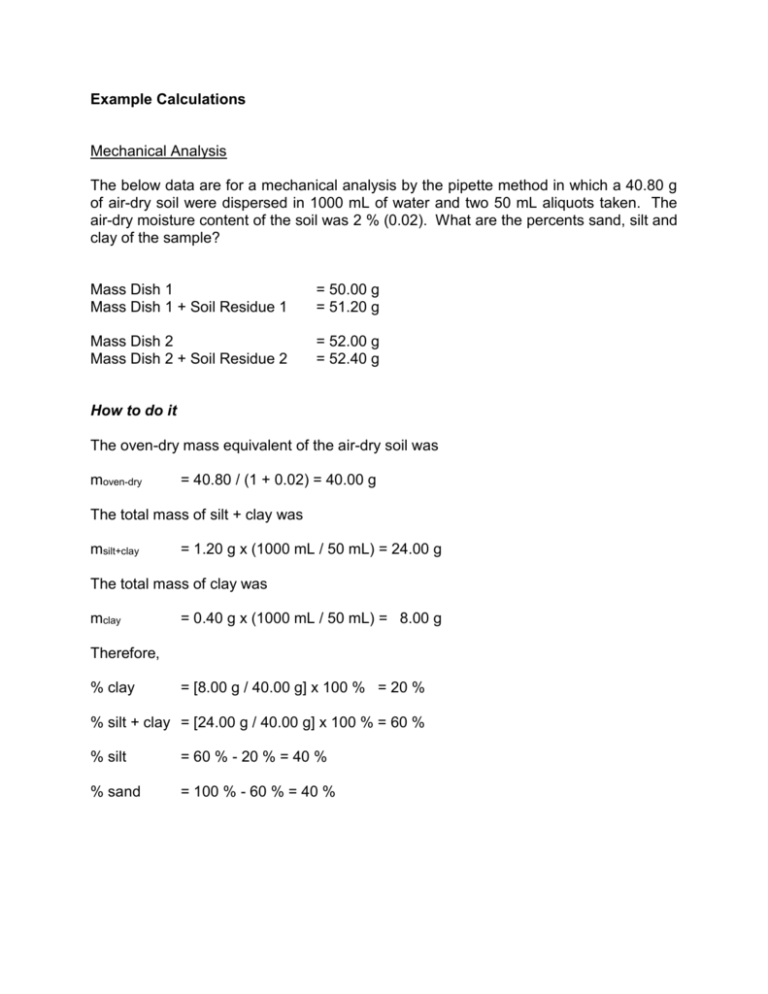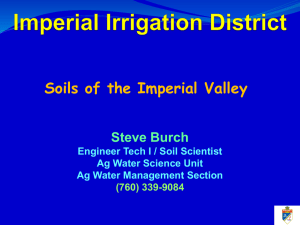Example Calculations
advertisement

Example Calculations
Mechanical Analysis
The below data are for a mechanical analysis by the pipette method in which a 40.80 g
of air-dry soil were dispersed in 1000 mL of water and two 50 mL aliquots taken. The
air-dry moisture content of the soil was 2 % (0.02). What are the percents sand, silt and
clay of the sample?
Mass Dish 1
Mass Dish 1 + Soil Residue 1
= 50.00 g
= 51.20 g
Mass Dish 2
Mass Dish 2 + Soil Residue 2
= 52.00 g
= 52.40 g
How to do it
The oven-dry mass equivalent of the air-dry soil was
moven-dry
= 40.80 / (1 + 0.02) = 40.00 g
The total mass of silt + clay was
msilt+clay
= 1.20 g x (1000 mL / 50 mL) = 24.00 g
The total mass of clay was
mclay
= 0.40 g x (1000 mL / 50 mL) = 8.00 g
Therefore,
% clay
= [8.00 g / 40.00 g] x 100 % = 20 %
% silt + clay = [24.00 g / 40.00 g] x 100 % = 60 %
% silt
= 60 % - 20 % = 40 %
% sand
= 100 % - 60 % = 40 %
Particle Density
The below data are for determination of particle density. Calculate the particle density.
Mass of picnometer
Mass of picnometer + air-dry soil
Gravimetric water content of the air-dry soil
Mass of picnometer + soil + water (picnometer filled with soil + water)
Mass of picnometer + water (picnometer filled with water)
20.00 g
40.80
0.04
52.42 g
40.00 g
How to do it
The oven-dry mass equivalent of the air-dry soil was
moven-dry
= 20.80 / (1 + 0.04) = 20.00 g
The volume of the picnometer filled with water when it also contained soil was
Vwater
= [52.42 gtotal – 20.00 gsolids – 20.00 gpicnometer] / 1.00 g mL-1 = 12.42 mL
The total volume of the picnometer was
Vtotal
= [40.00 g – 20.00 g] / 1.00 g mL-1 = 20.00 mL
Therefore, the volume of soil solids was
Vsolids
= 20.00 mL – 12.42 mL = 7.58 mL
Accordingly, the particle density of the soil was
ρS
= 20.00 g / 7.58 mL = 2.64 g mL-1 or 2.64 g cm-3
Bulk Density
A 100 cm3 sample of field-moist soil weighed 180 g. After drying at 105 oC for 24 h, it
weighed 150 g.
What was the bulk density of the soil?
How to do it
ρB
= 150 g / 100 cm3 = 1.50 g cm-3
What were the gravimetric and volumetric water contents of the field-moist soil?
How to do it
GW
= [180 g – 150g] / 150 g = 0.20
VW
= {[180 g – 150 g] / 1.00 g cm-3} / 100 cm3 = 0.30
Assuming a particle density of 2.60 g, what was the porosity of the soil? Also, what
fraction of the pore space was air-filled?
How to do it
Porosity = 1 – 1.50 g cm-3 / 2.60 g cm-3 = 0.42
Air-filled porosity = total porosity – VW = 0.42 – 0.30 = 0.13
Thus, the fraction of the total pore space filled with air was 0.13 / 0.42 = 0.25
Hydraulic Conductivity
You determine the saturated hydraulic conductivity of two soils, X and Y, under the
different conditions given below.
X
Y
Cross sectional area, A
Depth of soil, L
Constant depth of water, D
Average discharge rate, Q
10 cm2
10 cm
10 cm
10 cm3 h-1
80 cm2
5 cm
15 cm
16 cm3 h-1
What are the saturated hydraulic conductivities, K, of soils A and B? Also, if one soil is
a silt loam and the other is a clay loam, which is which?
How to do it
From Darcy’s Law, Q = KA{[D + L] / L},
K = Q / (A{[D + L] / L})
KsoilX = 10 cm3 h-1 / (10 cm2 {[10 cm + 10 cm] / 10 cm}) = 0.50 cm h-1
KsoilY = 16 cm3 h-1 / (80 cm2 {[15 cm + 5 cm] / 5 cm})
= 0.05 cm h-1
Thus, based on conductivities, soil X would be the silt loam and soil Y, the clay loam.
Air- and Water-Filled Pore Space (Degree of Water Saturation)
Continuing with the above, if 133.32 g of air-dry soil X were used, the gravimetric water
content of the air-dry soil is 1 %, its particle density is 2.64 g cm-3, and the total wet
mass of the soil was 177.00 g, what fraction of the pore space was filled with water?
How to do it
There were 177.00 g – [133.32 g / (1 + 0.01)] = 177.00 g – 132.00 g = 45.00 gwater (or
45.00 cm3) in the wet soil.
The maximum volume of water that the sample could have contained is the total pore
space, i.e., porosity x total volume,
(1 – ρB / ρS) x VT = [1 – (132.00 / 264.00)] x 100.00 cm3 = 50.00 cm3 water.
So, only 45.00 / 50.00 = 0.90 of the total pore space was filled with water.






